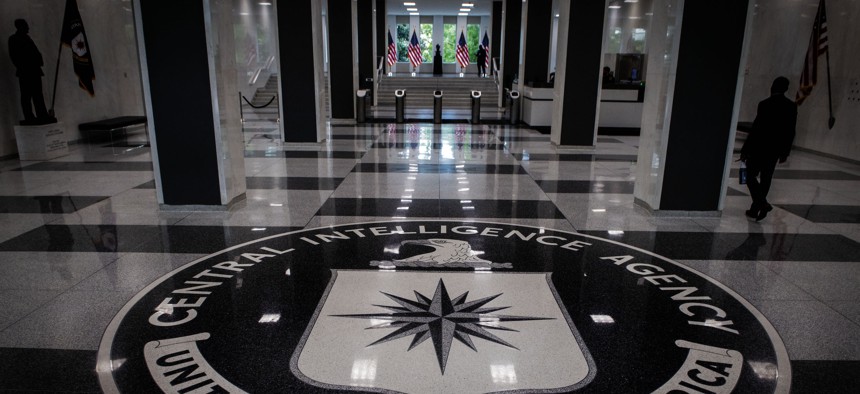
The agency seal on the floor of the lobby at the CIA, in Mclean, VA. Bill O'Leary/The Washington Post via Getty Images
Intelligence Agencies Seek Better Ways to Buy IT and Emerging Tech
Many contracting offices are short-staffed, even though nearly 80% of the IC's budget goes to contractors.
The focus on strategic competition with foreign adversaries has forced the IC to consider new ways to procure and implement emerging technologies and tools required to maintain an edge against competitors, according to John Beieler, director of science and technology for the Office of the Director of National Intelligence. That could mean a significant expansion in public-private cooperation across the community in the years to come, as well as an increased focus on cloud computing capabilities and other modernization initiatives.
“There isn’t anyone in the Intelligence Community that doesn’t believe that we need to be better about the acquisition and onboarding of new tech solutions,” Beieler told FCW.
What’s driving the procurement pressures on the intelligence community is a combination of the increasing near-peer competition and the fast-evolving dynamics of digital transformation. Where the domains of the Cold War were relatively fixed, the speed at which technology is evolving has broadened the attack surface to include new targets, such as critical infrastructure.
Those targets, and the speed of technological capability, mean the IC’s acquisition practices have to evolve quickly as well.
A February 2022 request for information from ODNI seeking input from the private sector and key stakeholders on the science and technology investment landscape offers an unclassified window into the world of IC procurement – a secretive space dominated by a handful of longtime incumbents – emphasizing enterprisewide science and technology challenges that may be better solved in the coming years by leveraging partners outside of the community, including the private sector and government agencies.
The size of the market is enormous. Scott Bumgarner, ODNI’s IC Senior Procurement Executive, told an industry gathering last May that close to 80% of the total IC budget — roughly $52.6 billion of $65.7 of the National Intelligence Program budget appropriated in fiscal 2022 — is spent in some way under contract. At the same time, across the IC contract office workforces frequently operate well below their optimal staffing levels.
The RFI requests information on how the IC can develop and improve standards and methods to address challenges associated with processing, reviewing and sharing spectral and spatiotemporal data in emerging computing and cloud architectures. The document also seeks input on ways to develop artificial intelligence and machine learning techniques for computer network defense operations, as well as methods to mitigate biases introduced by ML techniques.
“It’s hard to get a signal from the government often and it’s especially hard to get a signal from the IC of what the community cares about,” Beieler said. “So even though some of the needs are admittedly a little bit anodyne … having any signal, we found, is very valuable, and allows us to start the conversations with industry.”
Driving digital transformation
Cybersecurity and IT professionals across the IC face longstanding challenges when it comes to implementing emerging technologies and commercial cloud computing capabilities, from limited vendor options due to security concerns and the need for specialized capabilities, to budgeting constraints and issues with integrating new tools and legacy systems.
The 18 agencies that comprise the IC are still figuring it all out.
The National Geospatial Intelligence Agency has plans to replace legacy systems with a new enterprise management platform featuring automated data collection and dissemination capabilities.
The National Security Agency re-awarded a reported $10 billion cloud computing contract to Amazon Web Services earlier this year as part of an effort to modernize the agency's processing and analytical requirements.
And ODNI also plans to release a new RFI in about a year that will seek input on emerging technologies and cloud solutions that can be prioritized and implemented across the IC over a shorter timeline than the four-year window that was previously featured in the original document, according to Beieler.
“Like any good scientist, we’re always experimenting,” Beieler said. “We understand that a four or five-year time cycle is not really super useful to everyone, and frankly dropping a multi-page PDF document with hundreds of needs in it probably isn’t the best way we can go about this.”
Bumgarner noted in his remarks last May that while the pandemic did disrupt operations across the U.S. government, one of its benefits for the IC was demonstrating how agencies and contractors could operate remotely and potentially remove some of the clearance barriers that slow acquisition down.
“Where I came from, CIA, traditionally when we had a new contract, we would assume everything would assume that everything has to be at that upper-classification level,” he said. “By sheer necessity, we have had to, across the community, realize that not all parts of the work have to be at that higher classification level. And when you change the whole complexion of what can be done at an unclassified or lower-classified level, you fundamentally change the marketplace of who could have performed the work, and that is exciting.”
Space is the place
To maintain a competitive edge and continue advancing in the global technology arms race, the IC is increasingly relying on and leveraging emerging commercial partners to do the work that was traditionally done exclusively by nation states, according to Jake Harrington, an intelligence fellow at the Center for Strategic and International Studies.
Harrington, a former special assistant to the FBI chief information officer focusing on enterprise information technology modernization and cybersecurity, told FCW that commercial partnerships have played a significant role in shaping the IC’s digital capabilities in space.
"I've seen a lot of expansion of partners with commercial space providers for geospatial intelligence," Harrington said. "I think that's sort of the clearest area where there are compelling things like geospatial imagery and even some of the more advanced capabilities that are now in the commercial market.
"If the U.S. was looking just from a straight cost-benefit analysis, partnering with commercial capabilities that parallel what were the exclusive domain of nation states is a really smart business model,” he added.
But as with all forms of science and technology, figuring out how to procure the right tools while maintaining national security isn’t an easy task.
“You want to bring in the latest, greatest tech and you want to be able to prosecute your mission,” Bieler said. “But we really have to have a high level of assurance and robustness about all the tech that we deploy.
“It’s the balancing of those things: The speed and rapidity at which we want new tech, and really the level of assurance that we have to place on our critical missions,” he added.
Funding and budgeting challenges also remain a consistent issue across the board for the IC when it comes to procuring emerging technologies and software solutions.
“Because of how long budget bills and cycles are for both DOD and the IC, being able to rapidly adjust fire on big procurement programs is really challenging,” Harrington said. “It’s just the reality: Software moves more quickly than our budget cycles. Looking at different methods for acquiring software have been thrown out and evaluated, but they still haven’t really been implemented.”
This article originally ran in the January/February print edition of FCW.




